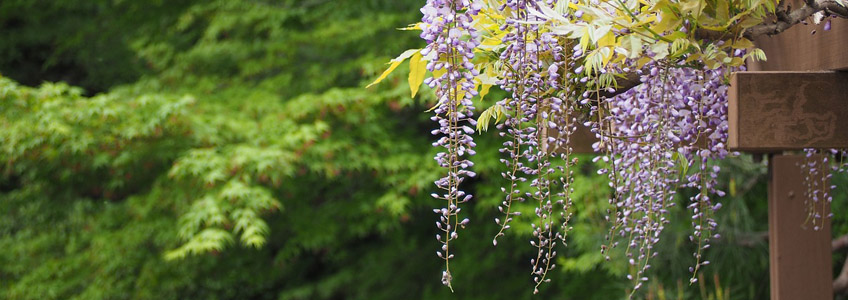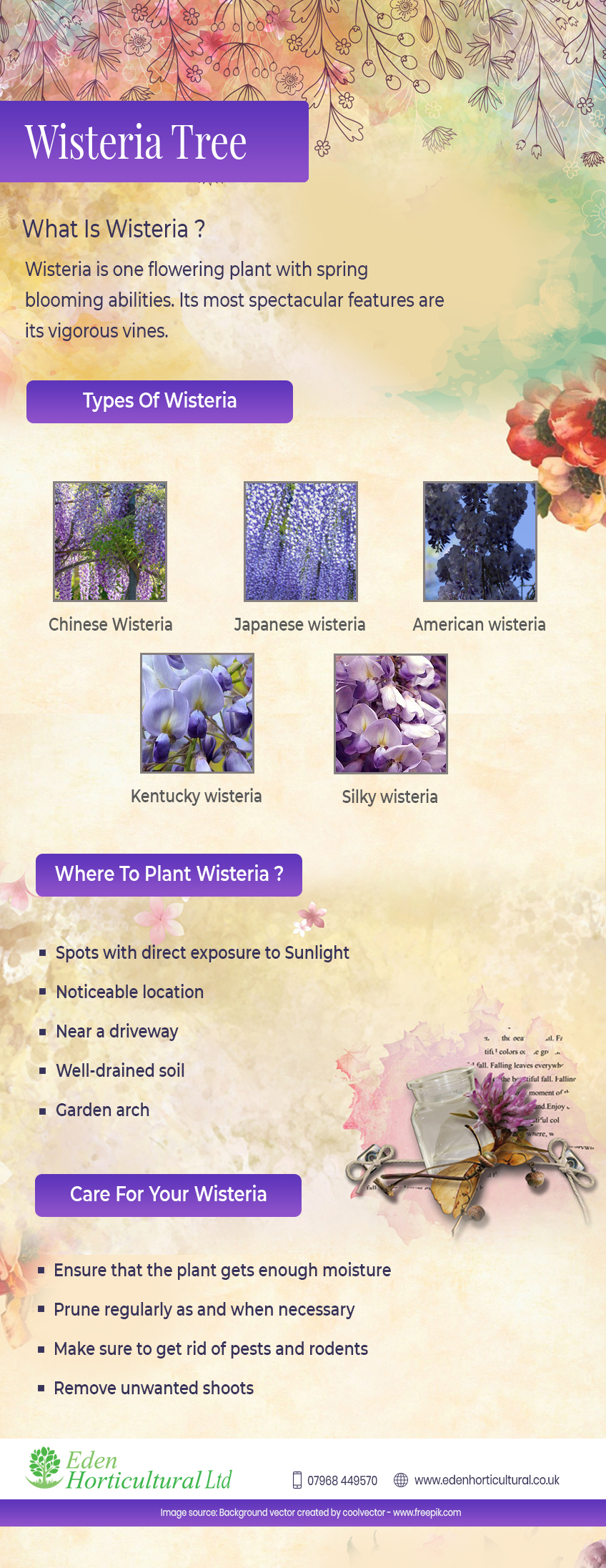Wisteria is a vining plant that looks spectacular and can beautify the home. Also, they have a strong fragrance and can grow very tall. Perhaps, you have seen pictures of wisteria in certain places, and you’re interested in growing yours. It is something you can achieve, but with patience. Although wisteria can be aggressive, with special care, you can train them and get the wisteria image you desire. This article would explore the types of wisteria, as well as how to grow and care for wisteria.
What Is Wisteria?
Wisteria is one flowering plant with spring blooming abilities. Its most spectacular features are its vigorous vines. Often referred to as climbing wisteria by some, wisteria has an abundance of flowers, mostly in blue and purple color. Also, you can notice other colors like in the pink wisterias or wisteria white. On average, the height of wisteria is between 10-30 feet, but this height differs with each type of wisteria.
Types Of Wisteria
There are different species of wisteria, but the most popular of them are the Chinese and Japanese wisteria varieties. Some other varieties include the American wisteria and the Kentucky wisteria. Although the wisteria varieties are from one species, it is crucial to identify the type of wisteria you have to enhance its growth.
-
Chinese Wisteria
Also known as wisteria sinensis, can grow as tall as 10-25 feet or higher. It produces a welcoming and pleasant smell, and the flowering period is between early spring and early summer. The flowers of the Chinese wisteria last longer than any other type, and the vines twist in a counterclockwise manner.
-
Japanese Wisteria
It is also known as wisteria floribunda. It can grow taller than Chinese wisteria – as high as 30 feet. The wisteria flowers of the Japanese type are heavily scented, and the flowering period is mostly in the middle of spring. It has the most color variety, and the vines twist in a clockwise manner. Also, they produce bright flower clusters.
-
American Wisteria
It is also known as wisteria frutescens. This type of wisteria can grow between 10-30 feet tall, depending on other factors. The American wisteria flowers are not heavily scented, and the wisteria flower buds bloom heaviest in the late spring. However, the vines do not produce as aggressively as the Asian wisteria.
-
Kentucky Wisteria
Which is also known as wisteria macrostachya has a growth height of 15-25 feet. Unlike the other wisteria varieties, its wisteria flower buds are moderately scented. Also, the wisteria flowers bloom in the late spring through early summer. The Kentucky wisterias have the latest blooming time.
-
Silky Wisteria
Which is also known as wisteria stachybotrys, grows to between 10-20 feet tall. The wisteria flowers are strongly scented, and they are an excellent choice for house walls or big pergolas.
How to Plant Wisteria?

Proper planting of wisteria is necessary to ensure growth. When planting, consider places that are fertile, moist and well drained. Also, ensure that you plant during spring or fall as these periods are ideal for the growth of wisteria, especially the white wisteria tree.
To plant your cuttings, dig a hole as deep as a root ball. Ensure it is three times as wide and each plant should be at least 12 feet apart from each other.
Where To Plant Wisteria ?
Wisteria is a unique flower plant that needs special places to grow well. Selecting a location for your wisteria is an important decision because it would affect how quickly your wisteria flowers bud. Sites you can consider planting wisteria include:
-
Spots With Direct Exposure To Sunlight
Wisteria needs to get at least six hours of direct sunlight daily to grow well.
-
Noticeable Location
Wisteria can quickly get out of control, and the vines can strangle the plant. Planting wisteria in a prominent place would enable you to remember to take care of it.
-
Near A Driveway
Wisteria near entrances would draw your attention to its need. Also, it would beautify the path.
-
Well-Drained Soil
White wisteria tree requires deep fertile soil alongside good sun to grow. The enriched soil allows water to circulate throughout the tree.
-
Garden Arch And Support Systems
Wisterias can also be planted on reliable support. The support systems should be strong enough for the dense vines and also encourage growth. The most common wisteria support ideas are arbors and wisteria pergola. Wisteria has a great climbing ability and can be trained to transform a garden in a few years. Wisteria can also be trained on trellises or over wall depending on the wisteria image you want to create. Whatever support system you decide on, ensure that it is strong and uses durable materials.
Where Not To Plant Wisteria ?
Whatever location you choose for your wisteria when you first plant it will eventually become its permanent location. This is because it is almost impossible to move wisteria later. Therefore, do not plant your wisteria in the following locations:
- Next To Your Residence: When wisterias are planted close to the house, the vines can overtake and penetrate the foundation of the house. They are fast growing and very strong, which can easily disrupt the structure of the house.
- Lightweight Garden Arch: The main reason why wisteria needs a good support structure is because of the firm and aggressively growing vine. As a result, making use of lightweight arch is not wise. The weight of the grapes could overwhelm the arch as the vines mature.
- Next To Other Plants: Wisteria can easily overwhelm nearby plants and stunt their growth. To avoid this, keep wisteria at a distance from other plants.
Getting Your Wisteria To Bloom
Certain factors affect how fast your wisteria blooms. Home gardeners are always so eager to know how to grow wisteria in a few months. However, growing wisteria to maturity takes a few years, and you might need to make use of fertilizers. Also, to get your wisteria to bloom, you need to consider pruning, exposure, and how the wisteria was planted.
For Gardeners in Chelmsford – Call: 01245 901537
Most people are unsure about whether to grow wisteria from seed or cuttings. Inside seed pods, there are large seeds that are easy to germinate, but the blooming rate could take as long as 15 years. Most likely, you would have given up on it before the wisteria flower buds. Therefore, you can consider propagating wisteria from cuttings. After planting, you need to monitor adequately and water regularly until the roots secure.
Wisteria is unable to survive in places that are cold and may be susceptible to frost damage. As a result, the wisteria flowers do not bloom. Also, ensure you do not use too much water or fertilizer as it can cause stunted growth and delay in blooming.
How to Care for Your Wisteria?
One of the significant needs of wisteria is care. If you don’t take care of them, they can overgrow in places you don’t want. Also, the vines twist on each other and can strain the plant. Therefore, consider taking the following steps in caring for your wisteria:
- If it doesn’t often rain where you want to grow your wisteria, put in extra effort to ensure that the plant gets enough moisture. Also, keep weeds in check.
- Prune regularly as and when necessary. Pruning is the secret to good flowering.
- Make sure to get rid of pests and rodents around the tree.
- Remove unwanted shoots.
In Conclusion
Wisterias are perennial flowering plants that can add ambiance to your residence. However, this cannot be achieved without proper planting and care of the wisteria. Most importantly, never leave your wisteria tree for long without attention.



